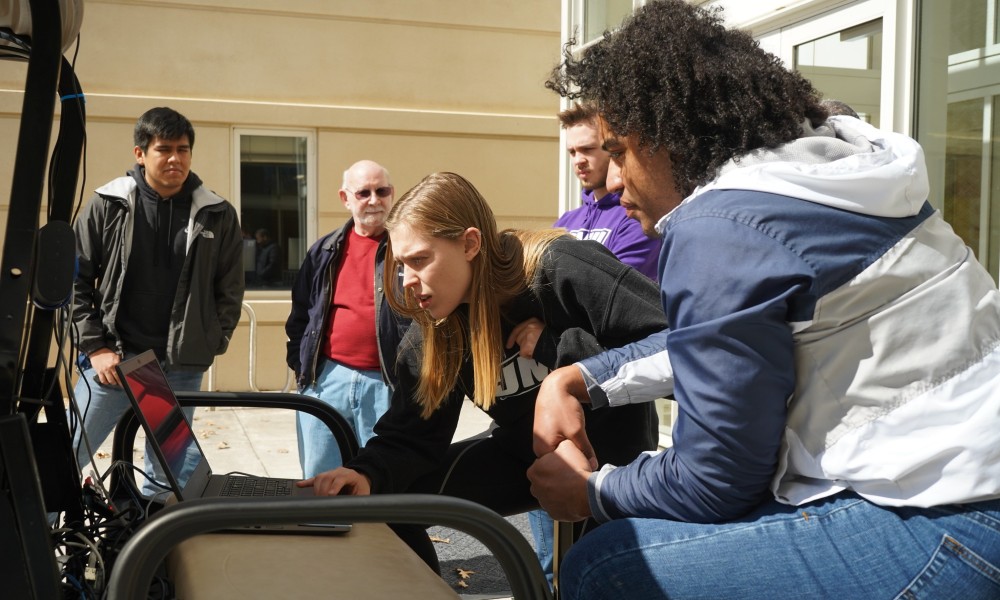JMU students develop autonomous vehicle for the elderly
News
By Lianne Boxley, CISE student writer
What do Tesla, Google, and JMU students have in common? They’re all paving the way for new discoveries in the autonomous vehicles industry. JMU’s Autonomous Vehicles class, led by integrated science and technology professor Samy El-Tawab and computer science professor Nathan Sprague, began in 2018. Students from a variety of majors and minors across JMU joined forces to build a self-driving golf cart, capable of avoiding obstacles, sensing pedestrians, and maneuvering a course entirely on its own.
The inaugural class won the 2018 Governor's Technology Award, received press coverage from several news outlets, and caught the eye of Dwight Miller, a Bridgewater Retirement Community (BRC) resident and retired architect. “That’s exactly the kind of thing that a lot of people who live here would benefit from,” says Miller. “We have people with mobility problems, we have people who can’t drive anymore, and it can be quite difficult for them to just get around the campus in these retirement communities.”
This new perspective led students from the 2019 Autonomous Vehicles class to explore new research to meet the unique needs of the elderly population living in retirement communities; including a user interface to adapt to passengers with vision and hearing difficulties, software to recognize a passenger medical emergency, and a network which would allow retirement community staff to remotely monitor the cart.
“There are a lot of people who struggle with mobility issues. I personally think that this is a place where autonomous vehicles can have a really positive impact in people’s lives….a lot of thought [must] go into how that system is going to work [and] how people are going to interact with it,” says Sprague.
To help students create the user interface, Sprague and El-Tawab brought in computer science professor and human-computer interaction (HCI) expert Michael Stewart and his team of students to conduct research on how the elderly interact with technology. “HCI is an interdisciplinary area of computer science where we include other fields, [such as] psychology, anthropology, sociology, design, all working together with computer science to answer questions about how people and technology can get along,” says Stewart.
In all, five teams contributed to this project: electronics and sensors, monitoring and networking, machine learning and perception, AI/Robotics, and human-computer interaction. “The burden wasn’t on one person to figure [everything] out,” says computer science major Mridul Pareek. “In the end, we had to make sure that everything [on the cart] worked together. So, having all the different people from different majors and different levels of experience really helped out.”
This project challenged students from ISAT, Computer Science, Physics, and Biology to conduct cutting-edge research, collaborate in a multidisciplinary setting and combine their areas of expertise to achieve a common goal. This type of collaborative teamwork is something that students like Alexandra Tremel see as unique. “Having this opportunity to work with different majors, and different ideas and professors on a one-on-one basis is really valuable [and] I think it’ll help me a lot,” remarks the ISAT major.
By the end of the Spring 2020 semester, students created a fully autonomous golf cart with a user-friendly interface designed for the elderly. The cart is able to actively monitor passengers, respond to their voice commands, and track their movements. “The students were able to do a project that’s real world,” says El-Tawab.
“The Autonomous Vehicles project is a great example of how we build bridges across disciplines at JMU and bring together multiple perspectives to solve challenging problems,” says Bob Kolvoord, Dean of the College of Integrated Science and Engineering. “Our students are discovering how computer science, ISAT, and engineering content and ideas impact human lives and this work prepares them not only to be more innovative in their future endeavors but also more attuned to the world in which those challenges reside.”
Although the semester is over, the work is not. Eight undergraduate students assisted by two JMU alumni are continuing the project as an independent study. They’re making improvements to the self-driving features of the cart, and continuing research on how the elderly interact with technology. “That’s something that’s really important to me – doing work that I feel is making a difference in people’s lives,” says computer science major Maddie Brower.
“We are the first undergraduate institution that is working on an autonomous vehicle specifically for the elderly in retirement communities,” says El-Tawab. “That’s something very unique and something we should be proud [of].”
The project has achieved tremendous success within the field of autonomous vehicles and in the local Harrisonburg community. Making such progress in an emerging technology provides a shining example of JMU’s ability to stay at the forefront of technological innovation.
